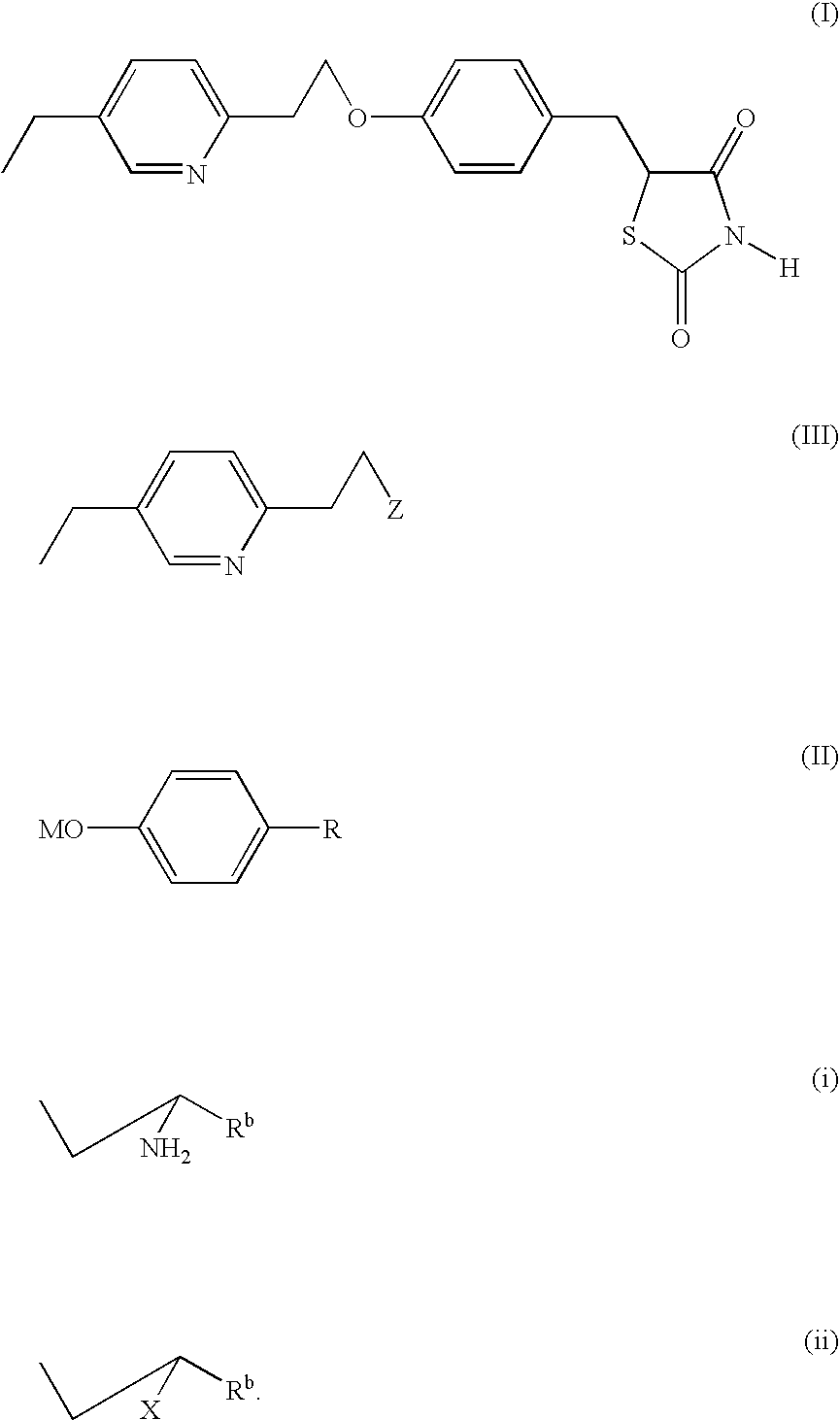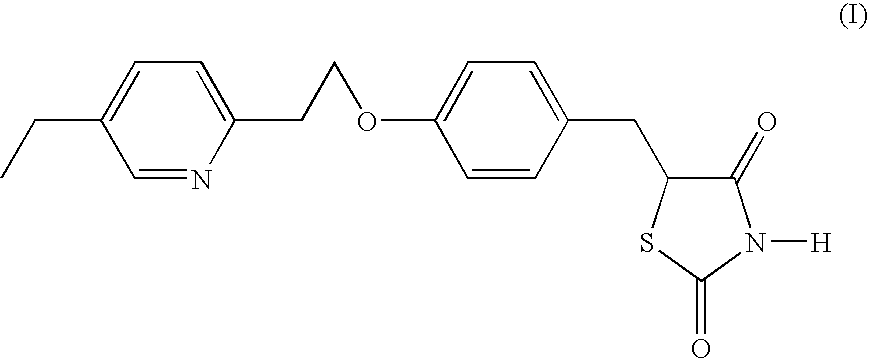Method for obtaining pioglitazone as an antidiabetic agent
a technology of pioglitazone and antidiabetic agent, which is applied in the direction of drug compositions, bulk chemical production, metabolic disorders, etc., can solve the problems of increasing the amount of impurities, the formation of large amounts of impurities, and the non-standard course of nitro group reduction on palladium
- Summary
- Abstract
- Description
- Claims
- Application Information
AI Technical Summary
Benefits of technology
Problems solved by technology
Method used
Image
Examples
example 1
Preparation of 4-(2-(5-ethyl-2-pyridyl)ethoxy)aniline
Preparation of 4-(2-(5-ethyl-2-pyridyl)ethoxy)acetanilide (Condensation—Two Different Starting Salts)
[0046]a) A mixture of 2-(5-ethyl-2-pyridyl)ethyl mesylate (3.64 g) and potassium 4-acetamidophenolate (3.32 g) in ethanol (18 ml) is agitated at 60° C. for six hours. The mixture is concentrated and extracted with ethyl acetate and water. The organic layer is washed 3× with a 0.2M solution of sodium hydroxide and 2× with water and dried with sodium sulfate. Evaporating the solvent and washing the residue with ether gives crystalline 4-(2-(5-ethyl-2-pyridyl)ethoxy)acetanilide (2.32 g, 51.3%; m.p. 85–87° C.).
[0047]b) To a solution of 2-(5-ethyl-2-pyridyl)ethyltosylate (15.27 g) in ethanol (50 ml) a solution of potassium 4-acetamidophenolate (9.47 g) in ethanol (40 ml) is added at 50–60° C. during 1.5 hours. The reaction mixture is agitated at the same temperature for another six hours, concentrated and extracted with ethyl acetate (1...
example 2
4-(2-(5-ethyl-2-pyridyl)ethoxy)aniline
Preparation of 4-(2-(5-ethyl-2-pyridyl)ethoxy)acetanilide
[0051]To a solution of 2-(5-ethyl-2-pyridyl)ethyl mesylate (1.7 g) and benzyltributylammonium chloride (0.5 g) in dichloromethane (10 ml) a solution of 4-hydroxyacetanilide (1.2 g) and potassium carbonate (1.1 g) in water (10 ml) is added. After agitating for 9 hours and heating to 75° C. the organic layer is separated, washed with water and dried over sodium sulfate. Evaporating the solvent and washing the residue with ether gives crystalline 4-(2-(5-ethyl-2-pyridyl)ethoxy)acetanilide (1.15 g; 54.8%; 82–85° C.).
Preparation of 4-(2-(5-ethyl-2-pyridyl)ethoxy)aniline
[0052]4-(2-(5-ethyl-2-pyridyl)ethoxy)acetaniline is obtained by hydrolysing
[0053]4-(2-(5-ethyl-2-pyridyl)-ethoxy)acetanilide as described in Example 1.
example 3
Preparation of 5-[[4-[2-(5-ethyl-2-pyridyl)ethoxy]phenyl]methyl]-2.4-thiazolidinedione (pioglitazone)
Preparation of 2-bromo-3-(4-hydroxyphenyl)-propionic acid
[0054]Tyrosine (20 g) is dissolved in HBr (100 ml, 48% diluted with 200 ml water). To the cooled solution NaNO2 in 30 ml water is added dropwise. The product is extracted with ethyl acetate and after common treatment 2-bromo-3-(4-hydroxyphenyl)-propionic acid is obtained, which is used without purification for the next step.
Preparation of 5-(4-hydroxybenzyl)-1,3-thiazolidine-2,4-dione
[0055]2-bromo-3-(4-hydroxyphenyl)-propionic acid is refluxed in ethanol (150 ml) with thiourea (14.7 g) and sodium acetate (16.32 g). After 3.5 hrs the solvent is evaporated. The residue is mixed in water, filtered off and washed with ether. A product (17.15 g) having the melting point 180.5–183.6° C. is obtained.
[0056]The obtained 5-(4-hydroxybenzyl)-2-imino-1,3-thiazolidine-4-one (16 g) is dissolved in methoxyethanol (150 ml) and HCl (27 ml) is a...
PUM
| Property | Measurement | Unit |
|---|---|---|
| temperature | aaaaa | aaaaa |
| temperature | aaaaa | aaaaa |
| temperature | aaaaa | aaaaa |
Abstract
Description
Claims
Application Information
 Login to View More
Login to View More - R&D
- Intellectual Property
- Life Sciences
- Materials
- Tech Scout
- Unparalleled Data Quality
- Higher Quality Content
- 60% Fewer Hallucinations
Browse by: Latest US Patents, China's latest patents, Technical Efficacy Thesaurus, Application Domain, Technology Topic, Popular Technical Reports.
© 2025 PatSnap. All rights reserved.Legal|Privacy policy|Modern Slavery Act Transparency Statement|Sitemap|About US| Contact US: help@patsnap.com



